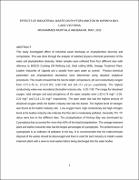| dc.description.abstract | This study investigated effect of industrial waste discharge on phytoplankton diversity and composition. This was done through the analysis of selected physico-chemical parameters of the water and phytoplankton diversity. Water samples were collected from four different sites with reference to BIDCO Cooking Oil Refining Ltd, Steel rolling Mills, Sewage Treatment Plant, Leather Industries of Uganda and a sample from open water as control. Physico-chemical parameters and phytoplankton abundance were determined using standard analytical procedures. The results showed that the Secchi depth, temperature, pH and conductivity ranged from 0.77-1.79 m, 27.0-27.9ºC, 6.50-7.00 and 101-153 μS/cm respectively. The highest conductivity value was recorded at the leather industry site. 6.20-7.80. The ranges for dissolved oxygen, total nitrogen and total phosphorus of the water samples were 1.83-5.76 mgl-1, 0.05-0.22 mgl-1 and 0.13-1.51 mgl-1 respectively. The open water site had the highest amount of dissolved oxygen while the leather industry site had the lowest. The highest level of nitrogen was found at the leather industry site. Low oxygen level, high conductivity and high nitrogen level at the leather industry site indicate that this site is moderately polluted. Generally TN: TP ratios were low in the different sites. The phytoplankton of Kirinya Bay was dominated by Cyanophyta that accounted for more than 60% of the total phytoplankton. The sewage treatment plant and leather industries sites had the largest percentages of cyanophytes. The predominance of cyanophytes is an indicator of pollution in the bay. It is recommended that the indiscriminate disposal of the wastes should be discouraged and there is need for each industry to install a waste treatment plant with a view to treat wastes before being discharged into the water bodies. | en_US |

